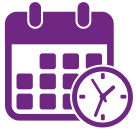Click on the below questions for answers to common questions we get from parents of children with diabetes.
What do I do if my child has ketones?
Ketones can occur when there is not enough insulin in the body to meet the body’s needs to produce energy. If there are enough of them in the blood, it can lead to nausea, vomiting, dehydration and ketoacidosis. This is serious. Ketones are monitored with a urine test. To prevent high levels of ketones two rules apply.
-
Give plenty of fluids whether normal food intake continues or not. If eating, these fluids should be sugar-free (unless of course, the blood sugar is low). If not eating, use fluids without sugar as long as the blood sugar is over 200 mg/dL. Switch to sugar-containing fluids when the blood sugars drop below 200. Fluids to use include:
-
If the blood sugar is high, diet soft drinks and water should be alternated with liquids like canned broth.
-
If there is nausea or vomiting, fruit juices/milk may be irritating to the stomach and should not be used until nausea/vomiting go away. 7UP®, ginger ale, Sprite®, Gatorade® or other non-caffeinated beverages can be used in this situation.
-
-
Ketones with high blood sugar require extra insulin be given. The extra insulin that is used is always rapid-acting (Humalog®, Novolog®, or Apidra®).
-
Call your doctor or nurse for directions regarding dosing of insulin or consult your after hours and weekend diabetes self-management booklet. If you still have questions after consulting your booklet and it is outside of office hours, call the nurse triage line.
-
If for some reason you cannot get to a phone quickly, it is safe to give an extra injection of Humalog®, Novolog® or Apidra® insulin when there are moderate or large ketones in the urine and the blood sugar is over 250 mg/dL. Use this guide: Child's Weight (In Pounds) ÷ 27 = Number of Insulin Units
-
These extra doses are meant to be given between the usual (scheduled) insulin injections. Novolog®/Humalog®/Apidra® is usually given every two hours as long as ketones are present. If extra Novolog®/Humalog®/Apidra® is given, give an extra 15 grams of carbohydrate right after injection is given (e.g. cup of juice).
-
It is always the best plan to call your doctor/nurse for instruction on insulin dose changes.
-
What do I do if my child is sick or vomiting?
Vomiting is a problem in any child, but particularly so in a child with diabetes. When a child is unable to keep fluids down, their body is not able to make enough urine to “wash” the extra sugar and ketones out. The sugar and ketones build up and make the illness even worse. Contacting the diabetes team is strongly recommended. The goals for caring for your child who is vomiting are:
-
Stop the vomiting: Rest the stomach by not giving anything by mouth for 30 to 60 minutes. This gives your child’s stomach a chance to recover.
-
If your child continues to vomit despite not eating or drinking for 30 to 60 minutes, you may use your prescription anti-nausea medicines such as ondansetron (Zofran®), promethazine (Phenergan®), or prochlorperazine (Compazine®).
-
-
Give fluids (liquids): Begin replacing fluids after 30 to 60 minutes if no vomiting.
-
Start by giving your child small amounts of fluids. Start with 1 teaspoon to 1 tablespoon every 15 minutes. If the blood sugar is under 200 mg/dL, use sugar-containing fluids. If the blood sugar is over 200 mg/dL, use sugar-free fluids.
-
If your child vomits the fluid, wait at least another 30 minutes and cut the volume in half from what you previously offered.
-
You may use frozen liquids if your child prefers such as ice chips or popsicles. These items are generally taken in slowly and tolerated well.
-
After 1 hour, if your child can keep down what was offered, you can increase the volume offered.
-
In general, solids should be held until there is no vomiting for a couple hours on liquids only. If your child is hungry and asking for food, try giving small amounts of a bland food first. This may include crackers, dry cereal, rice, or noodles. Avoid giving greasy, fatty, or spicy foods for a few days as your child recovers.
-
-
Test blood sugar every 2 to 3 hours and manage high or low blood sugars
-
Test and treat ketones every 2 to 3 hours
-
Never skip doses of long-acting insulin, even during illness
Call your diabetes care team if you have not been able to stop the vomiting. Your child may become dehydrated and very ill. Call your doctor or nurse for help, or call the nurse triage line if it is outside of office hours. Go to the nearest emergency department if:
-
Vomiting lasts 4 to 5 hours
-
Your child develops symptoms of dehydration such as:
-
Little or no urine for 8 hours
-
Dark colored urine
-
Excessive sleepiness
-
Extreme fussiness
-
Sunken eyes
-
Fast breathing or heart rate
-
Please note: If vomiting/nausea is associated with severe abdominal pain and/or fever, ondansetron can still be given, but you need to take your child to the emergency room so appendicitis or other potentially dangerous conditions can be ruled out.
What to do if my child has a low blood sugar?
Hypoglycemia (insulin reaction) happens when the blood sugar is too low. When the blood sugar drops, your body reacts to this and you may experience sign and symptoms, such as:
Signs of a mild reaction (mild hypoglycemia)
- Shaky
- Legs feel weak
- Hunger at an unusual time
- Difficult to pay attention
- Tired/sleepy
- Irritable
- Headache
- Pale
Mild reaction: If exercising, stop and rest. If possible, obtain a blood sugar level. Blood sugars below 70 mg/dL in ages 6 years and above and 80 mg/dL in ages under 6 years are considered to be in the hypoglycemic range. Sometimes symptoms of hypoglycemia can be present with higher blood sugars. This can happen when most of the blood sugars have been quite high, or when the blood sugar drops very quickly.
Eat 15 grams of a quick-acting carbohydrate:
- ½ cup fruit juice
- 4 Starbursts®, Skittles®, or Smarties®
- Fruit snacks
- 3 glucose tablets
Recheck the blood sugar in 15 to 20 minutes. If the blood sugar remains below 70 mg/dL, eat another 15 grams of a quick-acting carbohydrate.
Moderate reaction (moderate hypoglycemia): If the glucose remains below 70 mg/dL and the child cannot swallow and appears confused or very sleepy, help from others is always needed. Because the child cannot swallow, place a small amount of honey, cake gel or glucose gel inside the mouth between the cheek and gum. Repeat this until able to swallow. Then give a snack of complex carbohydrates such as granola bar, crackers, or toast. Always have glucagon and cake icing gel/honey/glucose gel available at home and school.
Signs of a severe reaction (severe hypoglycemia)
- Confusion
- Really sleepy/lethargic
- Seizures
- Loss of consciousness
Give glucagon right away. After giving glucagon, place the child positioned on his/her side. Call 911 as soon as possible.
Always contact your diabetes care team about severe insulin reactions. Changes in insulin dose are often needed.
How do I give glucagon? Watch this glucagon nasal powder (Baqsimi®) video and view these Glucagon Emergency Kit injections instructions.
How to prevent hypoglycemia:
- Do not skip meals
- Have extra food for exercise
- Carry a quick-acting sugar
What do I do if my child has a high blood sugar?
Sometimes it happens that the blood sugar is unusually high, outside a meal time, in a child who otherwise is feeling fine and has no urine ketones. Often this may be due to an error in calculating the dose of insulin for the previous meal or due to forgetting to give insulin at the previous meal. Understandably, high bedtime blood sugars tend to be especially concerning to parents.
If this is the case, typically nothing needs to be done as long as the blood sugar is below ~400 mg/dL. If it is at bedtime, the blood sugar will usually come down during the night under the effect of the long-acting insulin and because of the fact that no more food will be eaten.
If the blood sugar is over 400 mg/dL, a small dose of Humalog® or Novolog® can be given, without food, to decrease the blood sugar. If you are not sure how much to give, the following scale could be used:
- Age 12 years or older: 1 unit
- Age 6 – 12 years: 0.5 unit
- Age below 6 years: 0.25 unit
With this, the blood sugar will typically come down. If you want to, you can recheck the blood sugar three hours after the above dose of Humalog® or Novolog®. If the blood sugar did not decrease from its initial value, you can repeat the above dose. However, if the blood sugar dropped from its initial value (let’s say from 500 mg/dL to 420 mg/dL), we do not recommend to repeat the insulin dose.
A child using an insulin pump would use his/her normal correction dose under these circumstances.
What do I do if my child missed his/her long acting insulin (Lantus®/Basaglar®/Levemir®)?
-
If you realize between midnight and 7:30 a.m. that the previous night’s dose of Lantus® was missed, give ½ of the usual dose of Lantus® and call the office at 7:30 a.m. for further instructions.
-
If you realize between the time of the usual Lantus dose and midnight that the dose of Lantus® was missed, give the whole dose of Lantus® and call the office at 7:30 a.m. the next day for further instructions.
-
If this happens on a weekend (the office is not opened the next day) do the following:
-
If you gave ½ of the usual Lantus® dose [(scenario a)]: next evening, multiply the usual daily dose of Lantus® by 0.7, and give it that evening. That will cover the next 24 hours. Then the following evening, go back to the usual daily Lantus® dose.
-
If you gave the whole dose of Lantus® [(scenario b)]: next evening, multiply the usual daily dose of Lantus® by 0.9, and give it that evening. That will cover the next 24 hours. Then the following evening, go back to the usual daily Lantus dose.
-
What do I do if I am unsure if my child was given Lantus® or not?
- In this situation, it is recommended to periodically check the blood sugar throughout the night. If blood sugar is over 200 mg/dL with a significant rise from the evening baseline (for example the blood sugar was 220 mg/dL in the evening and is 300 mg/dL or higher at 1 a.m., or the blood sugar was 300 mg/dL at bedtime and is 350 mg/dL or higher at 1 a.m.), it is recommended to have a snack/small meal and use the evening or bedtime insulin/carb ratio to cover the meal with Humalog® or Novolog®. This can be repeated every 2-3 hours during the night. This way there will be insulin on board in case Lantus® was not given (the blood sugar may not necessarily drop significantly but that is okay). By not giving additional Lantus®, low blood sugars will be avoided in case Lantus® had been given in the evening.
What do I do if my child has a pump malfunction?
It happens uncommonly that the pump stops delivering insulin. If this is the case, please call the company service phone number located on the back of your pump right away. Usually a new pump will be sent out to you, but it may take a day or more to get it.
If this is the case, we use Lantus® injections to replace the 24 hour basal rates, and Humalog® or Novolog® injections for meal/snack boluses.
How much Lantus® to give: The number of units of Lantus® to give equals the total daily basal rate given by the pump. If you are still able to view the pump menus, you can find the total daily basal amount by locating the pump settings. You can also find this amount by looking at your most recent pump download (either a paper copy or directly on the downloading software/website.) Give this amount of Lantus® right away once you discover that the pump stopped delivering insulin.
How much mealtime insulin to give: In the same location that you are able to find the total daily basal amount, you will find the settings for insulin/carbohydrate (I/C) ratios to use throughout the day. Use these same ratios to determine how much insulin to give for carbohydrate meals/snacks (for example, I/C ratio is 10 – divide the number of carbohydrate grams by 10; the result is the amount of insulin to give for a meal).
How much correction to give: Giving corrections is not crucial and we only recommend to use corrections with meals/snacks, not outside meals, under these circumstances. If you want to correct for high blood sugars at mealtimes, use the following calculation:
-
Subtract the upper level of the target range from the existing blood sugar and then divide the results by the sensitivity factor for that time of day. This is the amount of insulin to be given as correction. Add this to the calculated mealtime dose.
-
Example: target range is 80-160. Sensitivity is 60. Existing blood sugar is 360 mg/dL. 360 minus 160 is 200. 200 divided by 60 is ~3 units. Add 3 units to the calculated mealtime dose of insulin and give this amount as one injection.
If you cannot locate the pump sheet/do not know what the total daily basal rate and insulin/carb ratios are: In this case, you will need to calculate the approximate amount of Lantus® and approximate insulin/carbohydrate ratios to use (it is not necessary to calculate the correction dose; your child’s blood sugars may be higher without a correction but she/he will not be in danger). How to calculate the dose of Lantus®:
-
-
Age 12 years and older: Multiply child’s weight in pounds by 0.5. Divide the result by 2. This will be the amount of Lantus® units to give.
-
Example: weight 100 lb. 100 X 0.5 = 50. 50 divided by 2 = 25. This will be the amount of Lantus® to give (25 Units).
-
-
Age 6–12 years: Multiply child’s weight in pounds by 0.35. Divide the result by 2. This will be the amount of Lantus® units to give (see above example of calculation).
-
Age below 6 years: Multiply child’s weight in pounds by 0.25. Divide the result by 2. This will be the amount of Lantus® units to give (see above example of calculation).
How to calculate insulin to carbohydrate ratios:
-
Age 12 years and older: Multiply child’s weight in pounds by 0.5. Divide the result by 2. Then divide 220 by this result. 220 is the approximate daily amount of carbohydrate grams eaten at this age.
-
The result you get is the insulin to carbohydrate ratio. Use this number to divide the amount of carbohydrate grams eaten. This will give you the amount of insulin to give for meals. Use this one insulin to carbohydrate ratio for the whole day. This will be different from the pump regimen but it will be fine for the time being.
-
Example: Weight is 100 lb. 100 X 0.5 = 50. 50 divided by 2 = 25. 220 divided by 25 is 9 (rounded up). Number 9 is the insulin/carbohydrate ratio that you would use throughout the day. If the child eats 70 grams for a meal, divide 70 by 9. This is 8 (rounded up). 8 is the amount of insulin units to give for this meal.
-
-
Age 6–12 years: Multiply child’s weight in pounds by 0.35. Divide the result by 2. Then divide 180 by this result. 180 is the approximate daily amount of carbohydrate grams eaten at this age.
-
The result you get is insulin to carbohydrate ratio. Use this number to divide the amount of carbohydrate grams eaten. This will give you the amount of insulin to give for meals. Use this one insulin to carbohydrate ratio for the whole day. This will be different from the pump regimen but it will be fine for the time being (see example for calculation).
-
Example: Weight is 50 lb. 50 X 0.35 = 17.5. 17.5 divided by 2 = 8.75. 180 divided by 8.75 is 21 (rounded up). Number 21 is the insulin/carbohydrate ratio that you would use throughout the day. If the child eats 50 grams for a meal, divide 50 by 21. This is 2.5 (rounded up). 2.5 is the amount of insulin units to give for this meal.
-
-
Age below 6 years: Multiply child’s weight in pounds by 0.25. Divide the result by 2. Then divide 140 by this result. 140 is the approximate daily amount of carbohydrate grams eaten at this age.
-
The result you get is the insulin to carbohydrate ratio. Use this number to divide the amount of carbohydrate grams eaten. This will give you the amount of insulin to give for meals. Use this one insulin to carbohydrate ratio for the whole day. This will be different from the pump regimen but it will be fine for the time being (see example for calculation).
-
Example: Weight is 30 lb. 30 X 0.25 = 7.5. 7.5 divided by 2 = 3.75. 140 divided by 3.75 is 37 (rounded down). Number 37 is the insulin/carbohydrate ratio that you would use throughout the day. If the child eats 40 grams for a meal, divide 40 by 37. This is 1 (rounded down). One is the amount of insulin units to give for this meal.
-
Please call our office on the next business day to discuss the situation involving the pump, the insulin doses and any other related issues. We will provide you with further instructions at that time.
You must wait until 24 hours after the last Lantus dose was given before resuming the insulin pump.
What special considerations do I need to remember when we go on vacation
Before taking a trip:
-
Get a paper copy of prescriptions in case you lose/break your insulin.
-
Pack twice as much medicine and testing supplies as you think you need.
-
Keep insulin cool with a travel pack including ice pack.
-
Keep carry-on supplies with you at all times; even if you are traveling by car.
-
Check batteries used and pack extra.
-
Pack your diabetes ID card and wear your ID.
-
Pack snacks to easily prevent or treat low blood glucose.
-
Pack other medicine or medical supplies such as anti-diarrhea and anti-nausea medicine, antibiotic ointment, Bandaids, and acetaminophen for fever or headache.
-
Wear comfortable shoes – avoid sandals and never go barefoot.
Traveling abroad:
-
Most insulins in the U.S. are U-100 (100 units per milliliter) strength and syringes are designed for U-100 strength. In foreign countries insulin may come in U-40 or U-80 strength. If you need to purchase insulin in a different strength, you will also need to purchase syringes in the correct strength to prevent overdose or under-dose of insulin.
Traveling across time zones:
-
Talk to your health care provider and make a schedule, as you will need to take your insulin at different times because you will be eating at different times.
-
If you use an insulin pump, discuss with your health care provider how to adjust your timed settings to account for the time difference.
-
Check your glucose often to prevent hypoglycemia. Your meal times as well as your activity levels will vary. Always carry snacks!
For more information, visit American Diabetes Association website – treatment and care – when you travel. Visit Transportation Security Administration (TSA) website for more information regarding traveling with diabetes.
How/where should I store my insulin?
Storage of insulin bottles
-
Once opened, insulin vials and pens do not need to be refrigerated. In fact, injections can sometimes be more painful when the insulin is cold.
-
Make sure not to expose insulin to extremes of temperature (freezing, heat over 86°F).
-
An unopened bottle of insulin is good until the expiration date if refrigerated.
View Insulin Storage Guidelines Chart











